Apple powermac g3 Service Manual

K Service Source
Power Macintosh G3/Macintosh
Server G3 (Blue and White)
Power Macintosh G3 (Blue and White), Macintosh Server G3 (Blue and White), Macintosh Server G3 with Mac OS X Server

K Service Source
Hot Issues
Power Macintosh G3/Macintosh
Server G3 (Blue and White)

Hot Issues |
Introduction - 1 |
|
|
|
|
Introduction
This chapter is designed to highlight unique or high-priority product issues that you should be aware of before servicing the Power Macintosh G3/Macintosh Server G3 (Blue and White) computer. Note: To avoid confusion with other products called “G3,” Service Source and Price Pages documentation added the words “Blue and White” after the product name.
This chapter alerts you to important issues and provides pointers to other areas in the manual where more complete information can be found.
To familiarize yourself with a new product family, always read the Basics chapter in its entirety. You should also refer to the Troubleshooting chapter for basic theory of operations information.

Hot Issues |
Processor Module vs. Card - 2 |
|
|
|
|
Processor Module vs. Card
Whereas previous Power Macintosh computers featured a user-installable processor card, this logic board uses a processor module that must not be removed by the customer (see “Processor Module” in the Take Apart chapter).
Processor Module Jumper
The Power Macintosh G3/Macintosh Server G3 logic board has a processor module jumper installed at J25. The processor jumper is color coded for the speed of processor module used (yellow jumper for 450 MHz, white jumper for 400 MHz, blue jumper for 350 MHz, and black jumper for 300 MHz). Failure to install the correct jumper may result in a computer that won’t boot up. (See “Jumper Location”) in the Troubleshooting chapter.

Hot Issues |
Warranty Sticker - 3 |
|
|
|
|
Warranty Sticker
There is a warranty sticker that covers the processor module jumper. The customer’s warranty is void if this sticker is tampered with. Apple-authorized service providers must replace this sticker if they have removed it during servicing to protect the customer’s warranty. (See “Processor Module” in the Take Apart chapter.)
Power Supply Voltage Setting
There is a switch on the back of the power supply that controls the voltage setting. The voltage switch must be set correctly to avoid damaging the computer. (See “Voltage Switch” in the Basics chapter for more information, including an international voltage chart.)

Hot Issues |
I/O Card - 4 |
|
|
|
|
I/O Card
Some I/O functions on the Power Macintosh G3/Macintosh Server G3 logic board are handled through a removable I/O card that must be installed for the computer to operate properly.
SDRAM DIMMS
The DIMM modules used in any previous Power Macintosh or Power Macintosh G3 computer model are not compatible with the Power Macintosh G3/Macintosh Server G3 (Blue and White) computers described in this manual. The SDRAM DIMM modules for these computers must be PC-100 compliant,168-pin, 3.3-volt, unbuffered, and rated at 125 MHz (8 ns) or faster.

Hot Issues |
SDRAM DIMMS - 5 |
|
|
|
|
|
Characteristics of the memory to be used in Power Macintosh |
|
|
G3/Macintosh Server G3 (Blue and White) are: |
|
|
• PC-100 SDRAM |
|
|
• 3.3 Volt unbuffered only |
|
|
• 168-pin module |
|
|
• Data width = 64 bits wide |
|
|
• Contains a correctly programmed Serial Presence Detect |
|
|
ROM (256 bytes) |
|
|
• Sizes of 32 MB, 64 MB, 128 MB in 64 Mbit technology are |
|
|
qualified. |
|
|
• Sizes of 128 MB and 256 MB in 128 Mbit technology are |
|
|
qualified. |
|
|
• Maximum DIMM height £ 2.0" |
|
|
• PC-100 SDRAM includes a sticker that clearly shows “PC- |
|
|
100” |
|

Hot Issues |
SDRAM DIMMS - 6 |
|
|
|
|
|
Do not use: |
|
|
• parity SDRAM DIMMs. |
|
|
• ECC (error correcting) SDRAM DIMMs. |
|
|
• registered or buffered SDRAM |
|
|
• DIMMs with fewer than 4 or more than 16 devices |
|
|
(irrespective of any PC-100 sticker or claims) |
|
|
(For more information see “SDRAM DIMMs” in the Basics |
|
|
chapter or refer to the Memory Guide.) |
|
|
“PC-100” is an Intel-driven standard for DIMMs compatible |
|
|
with Intel 100 MHz systems. Intel requires prominent |
|
|
marking of the DIMM as PC-100, and requires the speed |
|
|
code to be listed as well. Power Macintosh G3/Macintosh |
|
|
Server G3 (Blue and White) is compatible with 3-2-3 |
|
|
(slowest), 3-2-2, and 2-2-2 (fastest) speed codes. Power |
|
|
Macintosh G3/Macintosh Server G3 (Blue and White) will |
|
|
read the presence detect ROM for information about all the |
|

Hot Issues SDRAM DIMMS - 7
DIMMs installed in the machine, and set memory timing equal to the slowest DIMM.
Therefore, for maximum performance use only 2-2-2 speed codes. However, the difference in application performance between the speed codes is small. Power Macintosh G3/ Macintosh Server G3 (Blue and White) typically ships with a single 3-2-2 DIMM. This may change over time.
Power Macintosh G3/Macintosh Server G3 (Blue and White) is not compatible with all defined PC-100 DIMM sizes and organizations. In particular, do not use DIMMs using 256 Mbit SDRAMs; also, do not use DIMMs employing 32-bit-wide SDRAMs.
Power Macintosh G3/Macintosh Server G3 (Blue and White) cannot use the older EDO or Fast Page Mode DRAMs. In general, you will not be able to re-use DRAM from past Macintosh computers (8500, 8600, PM G3, iMac) in your

Hot Issues |
SDRAM DIMMS - 8 |
|
|
|
|
|
Power Macintosh G3/Macintosh Server G3 (Blue and |
|
|
White). However, there have been some recent efforts to |
|
|
qualify PC100 SDRAM for later versions of G3. |
|
|
Zero MB of memory is soldered to the Power Macintosh G3/ |
|
|
Macintosh Server G3 (Blue and White) main logic board. If |
|
|
the all four of the DIMM slots are empty, the machine will |
|
|
not operate. A single-frequency tone will be generated |
|
|
indicating that no memory is installed. |
|
|
The DRAM DIMMs can be installed one or more at a time. |
|
|
There are no performance gains when two DIMMs of the |
|
|
same size are installed. Any supported size DIMM can be |
|
|
installed in any DIMM slot, and the combined memory of all |
|
|
of the DIMMs installed will be configured as a contiguous |
|
|
array of memory. |
|
|
Using all four of the Power Macintosh G3/Macintosh Server |
|
|
G3 (Blue and White) DRAM DIMM slots, the maximum |
|

Hot Issues |
SGRAM Video Memory - 9 |
|
|
|
|
|
memory configuration will be 1024 Mbytes (1.0 gigabyte). |
|
|
When using 256 MB DIMMs in a Power Macintosh G3/ |
|
|
Macintosh Server G3 (Blue and White), be sure that the |
|
|
device technology that comprises the DIMM is 128 Mbit and |
|
|
not 64 Mbit or 256 Mbit. |
|
SGRAM Video Memory
The Power Macintosh G3/Macintosh Server G3 (Blue and White) computer does not include built-in video RAM nor a slot for video RAM expansion on the main logic board. The accelerated graphics card installed in the computer includes 16 MB of SDRAM video memory and does not support video RAM expansion.

K Service Source
Basics
Power Macintosh G3/Macintosh
Server G3 (Blue and White)
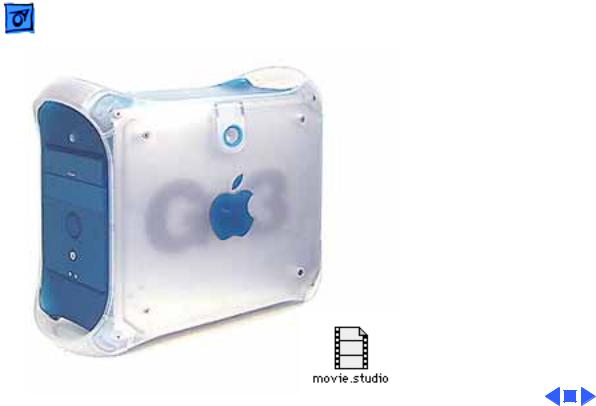
Basics |
Overview - 1 |
|
|
|
|
Overview
The Power Macintosh G3 computer is Apple’s leading performance and multiple configuration system for creative content customers. This Power Macintosh G3 provides a fast system architecture supported by improved and faster microprocessors, memory access, PCI bus, and I/O.
Click the movie icon at the left to view a QuickTime VR movie of the Power Macintosh G3.

Basics |
Features - 2 |
|
|
|
|
Features
There are standard features available with every Power Macintosh G3 computer, as well as configure-to-order features that are optional. The standard and optional features are listed below:
• Microprocessor : PowerPC G3 microprocessor running at a clock frequency of 300 MHz, 350 MHz, 400 MHz, or 450 MHz depending on model and configuration.
• Cache: 512K or 1 MB of backside second-level (L2) cache on processor module. The cache runs at half the clock frequency of the microprocessor.
• Processor system bus: 64-bit-wide data and 32-bit- wide address, 100 MHz clock, supporting split address and data tenures.

Basics |
|
Features - 3 |
|
|
|
||
• RAM: Four DIMM slots for 168-pin industry standard |
|||
|
SDRAM (synchronous dynamic access memory) DIMMs |
||
|
(dual inline memory modules). Maximum memory with |
||
|
all four slots occupied is 1024 MB. |
||
• |
ROM: New World ROM-in-RAM implementation with 1 |
||
• |
MB of BootROM. |
2D and 3D hardware graphics |
|
Graphics acceleration: |
|||
|
acceleration using the ATI RAGE 128 GL graphics |
||
|
controller on the 66 MHz 2D/3D accelerated graphics |
||
|
card. Software support through Macintosh QuickDraw 3D |
||
|
and QuickDraw 3D RAVE (rendering acceleration virtual |
||
|
engine) APIs. |
|
|
• |
Sound: Supports 16 bits/channel stereo input and |
||
|
output on built-in 3.5mm line-level stereo input and |
||
|
output jacks, one built-in speaker. |
||

Basics |
Features - 4 |
|
|
|
|
•Hard drives: Standard Macintosh configurations include one internal Ultra ATA hard drive, or one, two, or three internal Ultra2 LVD SCSI drives.
•Expansion bays: Three expansion bays, one of which is occupied by an Ultra DMA/33 hard drive or one Ultra2 LVD SCSI drive. Two bays are available for adding other devices connected to a PCI controller card.
•CD-ROM drive: Internal 24x or 32x ATAPI CD-ROM drive.
•DVD-ROM drive: Optional ATAPI DVD-ROM drive providing support for 32x-speed CD-ROM and 5x-speed DVD-ROM media, as well as DVD-Video playback with DVD MPEG2 decode module. The DVD MPEG2 decode module is connected to the PCI graphics card in DVD configurations.

Basics |
|
|
Features - 5 |
|
|
|
|
||
• Zip drive: |
Optional 100 MB ATAPI Zip drive. If the Zip |
|||
|
drive option is not installed at the time of purchase, data |
|||
|
and power connectors are provided to add an ATAPI Zip |
|||
|
drive to the system. A bezel for the Zip configuration will |
|||
|
need to be installed. The Zip device should be device- |
|||
|
select jumpered as Device 1. |
|||
• |
USB ports: |
The computer comes with two USB ports, a |
||
|
USB mouse, and a USB keyboard that has two additional |
|||
• |
USB ports. |
One ADB port for ADB devices or ColorSync |
||
ADB port: |
||||
|
control of Apple monitors. |
|||
• |
Ethernet: |
Built-in Ethernet port for a 10Base-T and |
||
|
100Base-TX operation with an RJ-45 connector. |
|||
• |
FireWire ports: |
Two IEEE-1394 high-speed serial |
||
|
FireWire ports, which support transfer rates of 100, |
|||
|
200, and 400 Mbps. |
|||
• |
Modem: Optional Apple 56Kbps modem. The modem |
|||
|
supports K56flex and V.90 modem standards. |
|||

Basics |
|
|
Features - 6 |
|
|
|
|||
• Keyboard: Apple USB keyboard with function keys and |
||||
|
inverted-T cursor motion keys. It is also a bus-powered |
|||
|
USB hub with two USB ports. |
|
|
|
• |
Mouse: Apple USB mouse operating as a low-speed (1.5 |
|||
• |
Mbps) USB device. |
Three slots for 33 MHz, |
||
PCI card expansion slots: |
||||
|
32-bit or 64-bit, up to a 12-inch PCI card; one slot for |
|||
|
a 66 MHz 32-bit PCI card, normally occupied by the |
|||
|
accelerated graphics card. |
|
|
|
• |
Power switch: |
Soft power controlled from the Apple |
||
|
USB keyboard and front power button. |
|||
• |
Voltage switch: |
Can be set to either 115 for voltages of |
||
|
100–130 V or 230 for voltages of 200–250 V, |
|||
|
depending on the voltage where the computer is installed. |
|||
|
The voltage selection must be set manually. |
|||

Basics |
|
|
Features - 7 |
|||
|
|
|
||||
• Fan speed control: |
The speed of the fan is thermally |
|||||
|
controlled and is automatically set to the lowest possible |
|||||
|
speed to minimize noise. The fan speed varies according |
|||||
|
to the temperature inside the enclosure. This is a |
|||||
|
function provided by the fan, and is not under software |
|||||
• |
control. |
Sleep, startup, and shutdown scheduling |
||||
Energy saving: |
||||||
|
can be controlled with an Energy Saver control panel. |
|||||
|
|
|
|
|
|
|
|
|
|
|
|
|
|

 Basics Configure-to-Order - 8
Basics Configure-to-Order - 8
Configure-to-Order
The build-to-order options that follow are available from the Apple Store. For more information view the build-to- order options online at the following address: http:// store.apple.com.
• internal 56K modem
• Ultra SCSI PCI card that comes with a 50-pin-to-25- pin SCSI adapter
• Ultra2 LVD SCSI PCI card, single channel
• Ultra2 LVD SCSI PCI card, dual channel
• DVD-RAM (ATAPI) drive
• Gigabit Ethernet PCI card
• 36 GB Ultra2 LVD SCSI hard drive
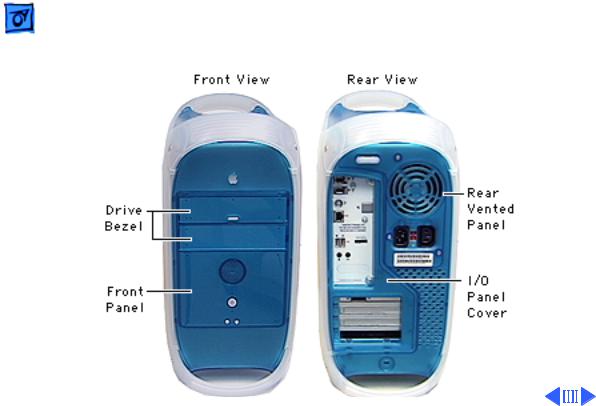
Basics |
Front and Rear View - 9 |
|
|
|
|
Front and Rear View
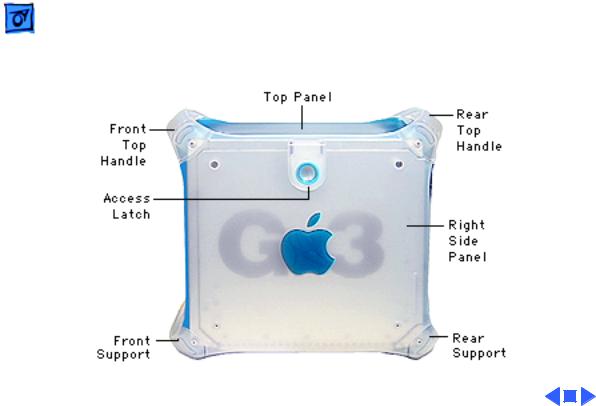
Basics |
Right Side View - 10 |
|
|
|
|
Right Side View
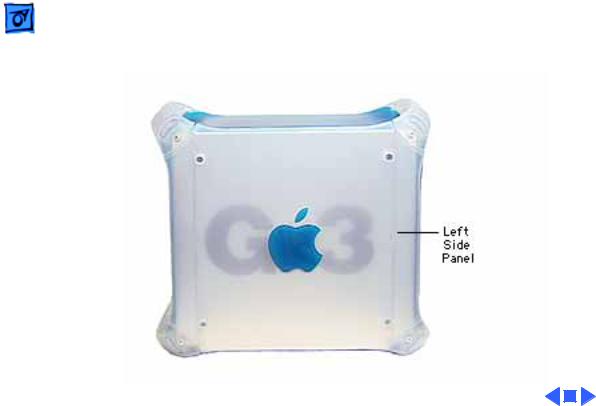
Basics |
Left Side View - 11 |
|
|
|
|
Left Side View
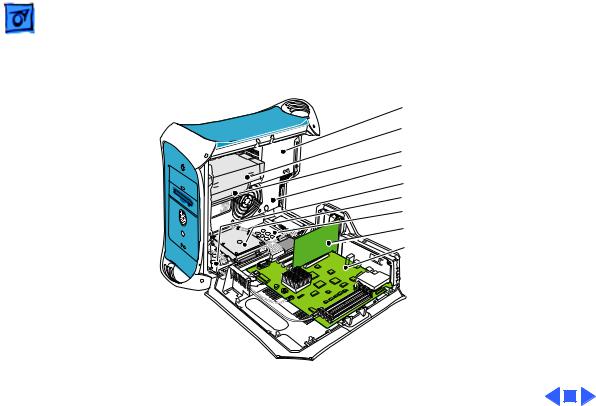
Basics |
Internal Locator - 12 |
|
|
|
|
Internal Locator
Power Supply
CD-ROM/DVD-ROM
Drive Bay
Zip Drive (optional)
Fan
Drive Bay 1
Drive Bay 2
Drive Bay 3
Monitor Card
Logic Board
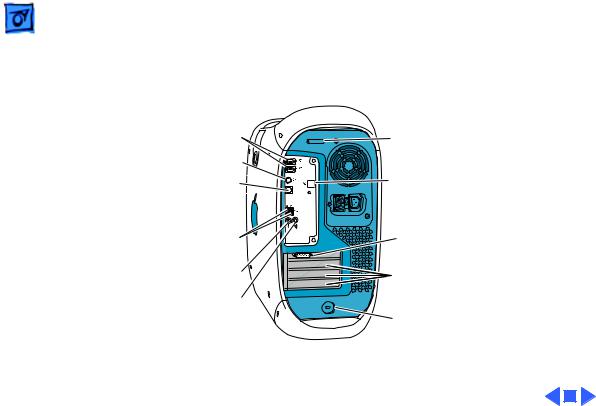
Basics |
I/O Panel/Rear View - 13 |
|
|
|
|
I/O Panel/Rear View
FireWire Ports (2) |
Lockable Cover Latch |
(ADB) Port |
|
Ethernet Port |
Internal Modem Card |
(10/100 |
(optional) |
Twisted-pair) |
|
USB Ports (2) |
Monitor Port |
|
(PCI Slot 1 or 2) |
Sound Input Port |
Expansion Slots |
Sound Output Port |
(PCI slots 2-4) |
|
|
|
Lock Down Location |
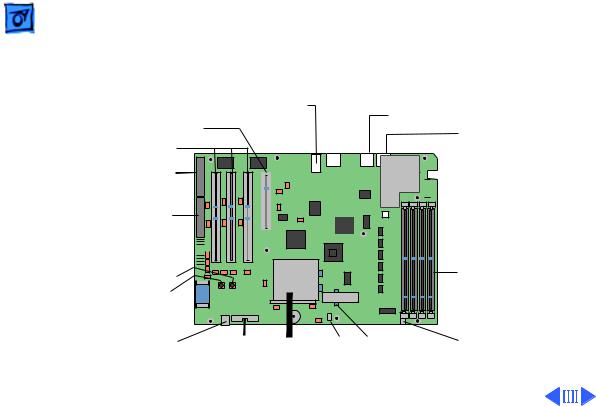
Basics |
Logic Board Diagram - 14 |
|
|
|
|
Logic Board Diagram
Monitor Card Slot
PCI Slots
J1 IDE
J15
Ultra2 ATA
J23 Power 



S5 Power Button
S4 Cuda Button
Battery 
Sound In & |
USB |
||||||
Sound Out |
Ports |
||||||
|
|
|
|
Ports |
A & B |
||
|
|
|
|
|
|
|
|
|
|
|
|
|
|
|
|
|
|
|
|
|
|
|
|
|
|
|
|
|
|
|
|
|
|
|
|
|
|
|
|
|
|
|
|
|
|
|
|
|
|
|
|
|
|
|
|
|
|
|
|
|
|
|
|
|
|
|
|
|
|
|
|
|
|
|
|
|
|
|
|
VOID Warrenty
Seal if Broken
Ethernet Connector
ADB
 Firewire Ports (2)
Firewire Ports (2)

 Modem
Modem
Connector
SDRAM
DIMM Slots
J8 CD Audio |
J31 |
Processor |
J34 J25 |
J2 Firewire |
|
Front Panel |
Plug-In |
Speaker Jumper Block |
Power |
|
Board |
Slot |
(w/sticker) |
|

 Basics RAM Expansion - 15
Basics RAM Expansion - 15
RAM Expansion
The Power Macintosh G3 logic board provides four PC-100 DIMM slots, supporting a maximum of 256 MB per DIMM, for a total of 1 GB.
Compatible DRAM DIMMs must meet all the following specifications:
• PC-100 Synchronous DRAM (SDRAM)
• 3.3 volt
• 64-bit wide, 168-pin module
• maximum of 16 memory devices on the DIMM
• unbuffered; do not use registered or buffered Synchronous DRAM (SDRAM)
• maximum height of 2.0 inches
DIMMs from older Macintosh computers may physically fit in the slots, but they are not compatible and should not be used.

Basics |
RAM Expansion - 16 |
|
|
|
|
|
Note: Zero MB of memory is soldered to the Power Macintosh |
|
|
G3 logic board. If all four of the DIMM slots are empty, the |
|
|
machine will not operate. A single-frequency tone will be |
|
|
generated indicating that no memory is installed. |
|
No Video RAM Expansion
The Power Macintosh G3 computer does not include built-in video RAM nor a slot for video RAM expansion on the main logic board. The accelerated graphics card that will be installed in the computer includes 16 MB of SDRAM video memory and does not support video RAM expansion.

Basics |
RAM Expansion - 17 |
|
|
|
|
No L2 Cache Expansion
The back-side L2 cache is integrated into the design of the microprocessor module. No cache expansion is possible without replacing the entire module.

Basics |
DVD-ROM and DVD MPEG2 Decode Card Module - 18 |
|
|
|
|
DVD-ROM and DVD MPEG2 Decode Card Module
The DVD-ROM drive configuration includes an DVD MPEG2 decode card module. The DVD MPEG2 decode card module supports viewing DVD video movies on a monitor connected to the 15-pin video output port on the PCI 2D/3D accelerated graphics card. DVD digital audio from the DVD media is sent to a DAC (digital-to-analog converter) and then to the Burgundy IC for analog stereo sound output to the currently selected sound output port.
